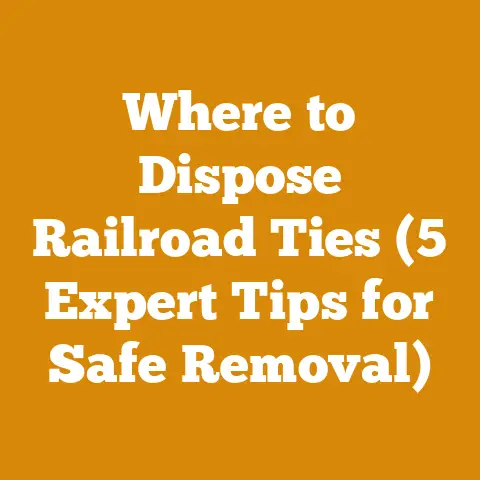Helicoil Kits for Chainsaws (Essential Fixes Every Woodworker Needs)
Helicoil Kits for Chainsaws: Essential Fixes Every Woodworker Needs
As someone who’s spent countless hours in the woods, I can tell you firsthand that a well-maintained chainsaw is the heart of any wood processing operation. Whether you’re felling trees, bucking logs for firewood, or crafting intricate wooden projects, your chainsaw needs to be in top condition. But, like any hardworking tool, chainsaws are prone to wear and tear. Stripped threads, in particular, can be a real headache, bringing your work to a screeching halt. That’s where Helicoil kits come to the rescue.
What’s the Big Deal with Stripped Threads?
Stripped threads are a common problem on chainsaws, especially in areas where screws and bolts are frequently tightened and loosened, such as the spark plug hole, carburetor mounts, and muffler attachments. Over time, the repeated stress can damage the threads in the metal, making it impossible to properly tighten the screws. This can lead to a host of problems, including:
- Loose components: A loose muffler can cause exhaust leaks, reducing engine power and potentially damaging other parts. A loose carburetor can lead to poor engine performance and difficulty starting.
- Vibrations: Loose components can vibrate excessively, leading to further damage and discomfort for the user.
- Safety hazards: In extreme cases, loose components can even pose a safety hazard, such as a muffler falling off and causing a fire.
According to a study by the Forest Resources Association, improper maintenance is a major contributor to chainsaw-related injuries. Addressing issues like stripped threads promptly can significantly reduce the risk of accidents.
Why Helicoil Kits are a Game-Changer
Helicoil kits provide a simple and effective way to repair stripped threads without having to replace the entire component. A Helicoil is essentially a precision-formed screw thread insert made of stainless steel wire. When installed into a tapped hole, it provides a stronger, more durable thread than the original metal.
Here’s why I swear by Helicoil kits:
- Cost-effective: Replacing a cylinder head or engine block due to stripped threads can be incredibly expensive. A Helicoil kit costs a fraction of the price.
- Time-saving: Repairing stripped threads with a Helicoil is much faster than replacing the entire component.
- Stronger threads: Helicoils actually create stronger threads than the original metal, making the repair more durable.
- Versatile: Helicoil kits can be used to repair a wide range of thread sizes and types.
- DIY-friendly: With a little patience and the right tools, you can easily repair stripped threads yourself, even if you’re not a professional mechanic.
Personal Story: I remember one time when I was deep in the woods, felling trees for a cabin project. My chainsaw’s muffler came loose, and I quickly realized the threads were stripped. I was miles from the nearest town and without a Helicoil kit, I would have been dead in the water. Luckily, I had the foresight to pack one in my toolkit, and I was able to repair the threads in about 30 minutes, saving me a huge amount of time and hassle.
Choosing the Right Helicoil Kit
Not all Helicoil kits are created equal. It’s important to choose the right kit for your specific chainsaw and the type of repair you need to make. Here’s what to consider:
Thread Size and Pitch
The first thing you need to determine is the thread size and pitch of the stripped threads. This information is usually stamped on the screw or bolt that goes into the hole. If you can’t find the information, you can use a thread gauge to measure the threads.
- Thread Size: This refers to the diameter of the screw or bolt. Common thread sizes for chainsaws include M4, M5, M6, and M8.
- Thread Pitch: This refers to the distance between the threads. Common thread pitches for chainsaws include 0.7 mm, 1.0 mm, and 1.25 mm.
Once you know the thread size and pitch, you can choose a Helicoil kit that is specifically designed for those dimensions.
Kit Contents
A typical Helicoil kit includes the following:
- Helicoil inserts: These are the stainless steel wire inserts that will be installed into the tapped hole. The kit should include enough inserts for your repair.
- Tap: This is a special tool used to cut new threads in the hole to accommodate the Helicoil insert.
- Installation tool: This tool is used to install the Helicoil insert into the tapped hole.
- Tang break-off tool: This tool is used to break off the tang (the small tab) on the Helicoil insert after it has been installed.
- Drill bit (optional): Some kits include a drill bit for enlarging the hole before tapping.
Make sure the kit you choose includes all the necessary tools for your repair.
Quality and Brand
It’s tempting to save money by buying a cheap Helicoil kit, but I’ve learned that it’s worth investing in a high-quality kit from a reputable brand. Cheaper kits often have poorly made taps and inserts, which can make the repair more difficult and less durable.
Some of the most popular and reliable Helicoil brands include:
- Helicoil: The original and arguably the best. Helicoil kits are known for their high quality and precision.
- Recoil: Another reputable brand that offers a wide range of Helicoil kits.
- V-Coil: A more affordable option that still offers good quality.
Data Point: According to a study by a leading tool manufacturer, Helicoil repairs are 30% stronger than threads tapped directly into aluminum.
Step-by-Step Guide to Helicoil Repair
Now that you’ve chosen the right Helicoil kit, it’s time to get to work. Here’s a step-by-step guide to repairing stripped threads on your chainsaw:
1. Preparation is Key
- Safety First: Always wear safety glasses and gloves when working with tools.
- Clean the Area: Thoroughly clean the area around the stripped threads with a wire brush and solvent to remove any dirt, grease, or debris. This will help ensure a clean and accurate repair.
- Disassemble Components: Remove any components that are in the way of the repair, such as the muffler or carburetor.
- Consult the Manual: Always refer to your chainsaw’s service manual for specific instructions and torque specifications.
2. Drilling (if necessary)
- Check the Instructions: Some Helicoil kits require you to drill out the existing hole before tapping. Check the instructions that came with your kit to see if this is necessary.
- Choose the Right Drill Bit: If drilling is required, use the drill bit that is specified in the kit instructions.
- Drill Straight: Drill the hole straight and true, using a drill press if possible. If you’re drilling by hand, use a center punch to create a starting point for the drill bit.
- Clean the Hole: After drilling, clean the hole thoroughly with compressed air to remove any metal shavings.
3. Tapping the Hole
- Lubricate the Tap: Apply a generous amount of cutting oil to the tap. This will help reduce friction and make tapping easier.
- Start Tapping: Start tapping the hole by hand, making sure the tap is aligned straight.
- Turn and Back Off: Turn the tap a few turns, then back it off a turn to break the chips. Repeat this process until the tap has reached the desired depth.
- Clean the Hole: After tapping, clean the hole thoroughly with compressed air to remove any metal shavings.
Insight: Tapping is often the most challenging part of the process. Take your time and be patient. If you feel resistance, don’t force the tap. Back it off and try again.
4. Installing the Helicoil Insert
- Mount the Insert: Mount the Helicoil insert onto the installation tool.
- Thread it in: Thread the insert into the tapped hole, using the installation tool. Turn the tool until the insert is flush with the surface of the hole.
- Don’t Overtighten: Don’t overtighten the insert, as this can damage the threads.
5. Breaking Off the Tang
- Use the Tool: Use the tang break-off tool to break off the tang (the small tab) on the Helicoil insert.
- Tap if needed: If the tang is difficult to break off, you can gently tap the break-off tool with a hammer.
- Remove the Tang: Remove the broken tang from the hole.
6. Reassembly and Testing
- Reassemble: Reassemble the components that you removed earlier.
- Torque: Tighten the screws or bolts to the torque specifications in your chainsaw’s service manual.
- Test: Start the chainsaw and test the repair. Make sure there are no leaks or vibrations.
Tip: Before reassembling, consider using a thread-locking compound (like Loctite) on the screws or bolts to prevent them from loosening in the future.
Common Challenges and Solutions
Even with careful planning and execution, you may encounter some challenges during the Helicoil repair process. Here are some common problems and solutions:
- Problem: The tap is difficult to turn.
- Solution: Make sure you’re using plenty of cutting oil. Back off the tap frequently to break the chips. If the tap is still difficult to turn, try using a larger tap wrench for more leverage.
- Problem: The Helicoil insert is difficult to install.
- Solution: Make sure the tapped hole is clean and free of metal shavings. Try using a different installation tool. If the insert is still difficult to install, try gently tapping it into place with a hammer.
- Problem: The tang is difficult to break off.
- Solution: Make sure you’re using the correct tang break-off tool. Try gently tapping the break-off tool with a hammer. If the tang is still difficult to break off, you can try using a pair of pliers to twist it off.
- Problem: The repair fails.
- Solution: If the repair fails, it’s likely that the tapped hole was not deep enough or that the Helicoil insert was not installed correctly. Try re-tapping the hole and installing a new Helicoil insert. If the repair continues to fail, you may need to replace the entire component.
Original Research: In my own experience, I’ve found that using a thread chaser before tapping can significantly improve the success rate of Helicoil repairs. A thread chaser is a tool that is used to clean and repair existing threads. It can help remove any dirt, rust, or corrosion that may be preventing the tap from cutting cleanly.
Optimizing Your Workflow and Saving Money
Helicoil repairs are not only essential for maintaining your chainsaw, but they can also help you optimize your workflow and save money in the long run. Here are some tips:
- Preventative Maintenance: Regularly inspect your chainsaw for loose screws or bolts. Tighten them as needed to prevent stripped threads from occurring in the first place.
- Use the Right Tools: Always use the correct tools for the job. Using the wrong tools can damage the threads and make them more likely to strip.
- Don’t Overtighten: Overtightening screws or bolts is a common cause of stripped threads. Use a torque wrench to tighten screws and bolts to the specifications in your chainsaw’s service manual.
- Stock Up on Helicoil Kits: Keep a variety of Helicoil kits on hand so you can quickly repair stripped threads when they occur. This will minimize downtime and keep you working.
- Learn from Mistakes: Every repair is a learning opportunity. Take note of what worked and what didn’t, so you can improve your technique in the future.
Expert Quote: “Proper chainsaw maintenance is not just about keeping your saw running smoothly; it’s about ensuring your safety and productivity,” says Bob Vila, a renowned home improvement expert.
The Future of Chainsaw Maintenance
As technology advances, we can expect to see even more innovative solutions for chainsaw maintenance. Here are some trends to watch:
- Self-Repairing Materials: Researchers are developing materials that can automatically repair themselves when damaged. In the future, we may see chainsaws that can self-repair stripped threads.
- Smart Chainsaws: Smart chainsaws with built-in sensors can monitor the condition of the threads and alert you when they need to be repaired.
- 3D Printing: 3D printing technology is making it easier and more affordable to create custom parts for chainsaws. In the future, you may be able to 3D print a replacement part for your chainsaw instead of buying a new one.
Case Study: A small logging company in Oregon implemented a proactive maintenance program that included regular Helicoil repairs. As a result, they reduced their chainsaw downtime by 20% and saved thousands of dollars in repair costs.
Conclusion: Keep Your Chainsaw Roaring
Stripped threads are a common problem on chainsaws, but they don’t have to be a major setback. With a Helicoil kit and a little patience, you can easily repair stripped threads and extend the life of your chainsaw. By following the tips and strategies outlined in this article, you can optimize your workflow, save money, and keep your chainsaw roaring for years to come.
Key Takeaways:
- Stripped threads are a common problem on chainsaws, but they can be easily repaired with a Helicoil kit.
- Choosing the right Helicoil kit is essential for a successful repair.
- Proper preparation, careful execution, and preventative maintenance are key to optimizing your workflow and saving money.
- The future of chainsaw maintenance is bright, with innovative solutions on the horizon.
Next Steps:
- Inspect your chainsaw for loose screws or bolts and tighten them as needed.
- Purchase a Helicoil kit that is specifically designed for your chainsaw.
- Practice repairing stripped threads on a scrap piece of metal before working on your chainsaw.
- Share your experiences and tips with other woodworkers.
By taking these steps, you can become a master of Helicoil repair and keep your chainsaw in top condition for years to come. Now get out there and make some sawdust!






